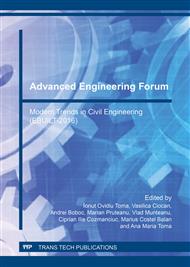p.135
p.141
p.151
p.161
p.169
p.175
p.183
p.190
p.196
Experimental Test and Numerical Analysis of Old Masonry Walls Strengthened with Glass Fiber Reinforced Mineral Composite
Abstract:
Masonry structures are commonly used in Romania and not only. This is due to its many advantages in terms of mechanical behavior based on increased capacity of stress redistribution. In addition to traditional strengthening solutions, composite materials are an advantageous alternative due to the high strength versus weight ratio. This paper presents an experimental and numerical analysis on old brick masonry specimens made with weak lime mortar and limestone sand, subjected to uniaxial compression. The results were compared with finite element numerical analysis in order to show stress distribution between brickwork and strengthening layers applied. Several forms of strengthening application relative to masonry faces (interior and exterior) were considered in the numerical analysis. The beneficial effect on the mechanical behavior of strengthened masonry in terms of stress and strain distribution of both masonry and strengthening layers is shown to be dependent on the thickness of the strengthening layer.
Info:
Periodical:
Pages:
169-174
Citation:
Online since:
March 2017
Authors:
Price:
Сopyright:
© 2017 Trans Tech Publications Ltd. All Rights Reserved
Share:
Citation:


